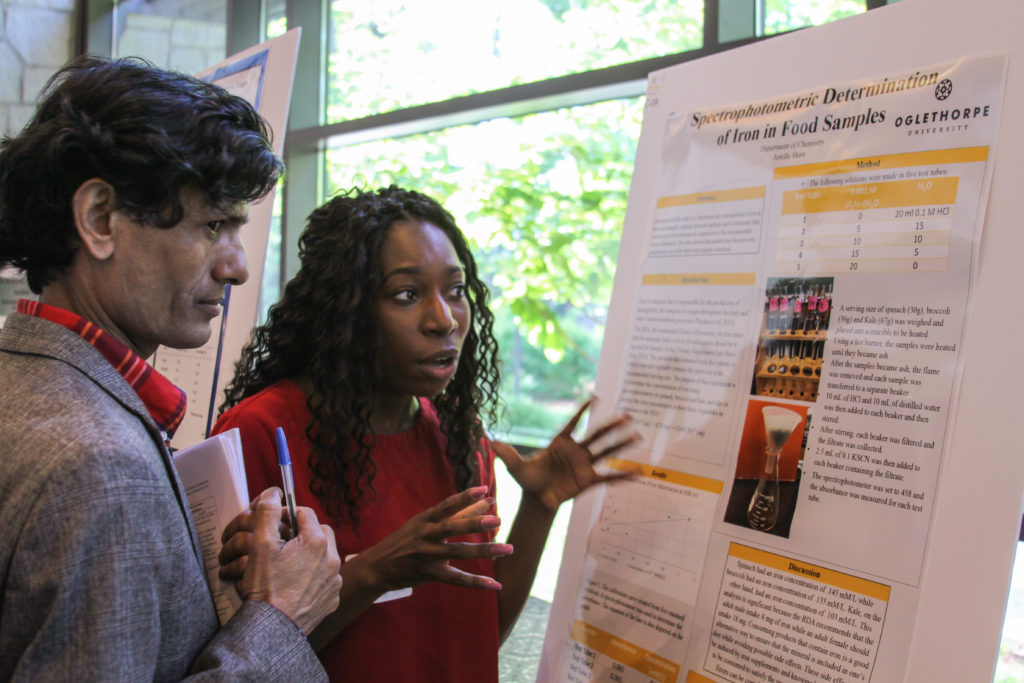More questions, fewer answers – at Oglethorpe, science is all about discovery
Whether you’re an Atlanta resident or a passing traveler, you can’t help but notice the striking silhouette of the Bank of America Plaza. This skyscraper isn’t just the highlight of our famous Atlanta skyline. It’s also the tallest building in Georgia and the 11th tallest building in the United States.
 So just how tall is the Bank of America Plaza, exactly?
So just how tall is the Bank of America Plaza, exactly?
A group of budding scientists in Dr. Mariel Meier’s introductory physics course decided to answer that question for themselves.
The project fulfilled the final challenge of the semester: choose something unique to accurately measure… then figure out how to measure it.
“They were very careful about it,” says Dr. Meier. “They measured the difference between street level and the first floor, and the outside to the center of the building.”
The physics course assignment is a fresh update on a more traditional one. In the past, students were given a preselected list of potential stuff to measure: the mass of Stone Mountain, the perimeter of Atlanta, the distance to the sun.
But the new project tosses the list aside. Students choose their question from the very beginning—which also means even the professor might not initially be sure how to answer it.
“These projects aren’t necessarily as polished or as easily answerable,” Dr. Meier says. “That can be frustrating for students, but also adds to the authenticity of the experience. It’s a very valuable thing to realize that science doesn’t always happen perfectly the first time.”
“In this day and age, information access is easy. Skill development, and the ability to frame a question and test it with an experiment, is really an art as well as a science.”
The measurement project is one small example of a much broader change that’s transforming the science curriculum at Oglethorpe—a move to challenge students with more questions, while providing a lot fewer answers. Because as any working scientist can tell you, that’s what the big, beautiful, messy process of science is really all about.
This transformation in science pedagogy is a larger trend taking hold in the best colleges and universities across the country, and Oglethorpe is at the leading edge.
The transformation is changing the way students think about science. And hopefully inspiring an enthusiasm for asking questions and a passion for problem-solving that will stay with students for a lifetime.
At Oglethorpe, the biggest changes have happened in the biology department, spearheaded by professors Dr. Lea Alford, Dr. Charlie Baube, Dr. Roarke Donnelly and Dr. Karen Schmeichel. The old format for intro to biology was a year-long survey course, often retreading ground students had already covered in high school. Lectures emphasized terminology and vocabulary. Students spent a lot of time memorizing. Labs were simple and straightforward, giving students unequivocal directions from Point A to Point B—more like following a recipe then embarking on a voyage of discovery.
This model of science pedagogy might have made sense for the 20th century—but requires an update for the 21st.
“Now the emphasis is about process,” says biology professor Dr. Baube, who teaches the intro class as well as courses in anatomy, physiology and animal behavior. “The content is important, but it’s no longer the focus. In this day and age, information access is easy. Skill development, and the ability to frame a question and test it with an experiment, is really an art as well as a science.”Oglethorpe’s new intro to biology course is called Biological Inquiry, and it’s all about asking questions. Lab and lecture are integrated, and students learn while doing.
The course is anchored by four core modules, each one a biological microcosm: bird behavioral ecology, worm genetics, frog heart physiology and plant growth physiology. The modules invite hands-on learning. “Students posit an experimental hypothesis and develop an experimental design,” says Dr. Schmeichel, associate professor of biology and division chair. “They’re responsible for running the experiment in the class, in the lab, on their own.”
In the worm module, students focus on C. elegans, a transparent, one-millimeter roundworm that’s also studied by many working scientists. Students learn how to design and execute an experiment using the worms as a model system. In later biology courses, students will do more complex experiments with C. elegans and even conduct original research.
In the plant ecology module, students explore phototropism—the way a plant grows toward the light. How do they do this? In this module, students also draw on knowledge from biostatistics, the co-required course on applying and analyzing quantitative data in biological studies.
This spirit of innovation is putting Oglethorpe on the map as a leader in science pedagogy.
Of course, a more student-engaged approach to learning does pose its own set of classroom challenges. As Oglethorpe breaks ground, both students and professors are learning as they go.
For Dr. Baube, one challenge is learning to step back and let students learn for themselves. “Most scientists are micromanagers,” he says. “But students have to be empowered to do projects like this, and given the leeway to make it their own and make some mistakes along the way.”
Dr. Meier agrees. “Sometimes you see a student going off on a tangent and you know it’s not going to really work for them.” But while it’s a lot less certain as the instructor—and as Dr. Meier says, “a lot more nerve-wracking”—she realizes it’s a much more effective way for students to learn.
The rewards are bigger, too. “When a student or a group is successful at figuring something out, that when they started even I didn’t know if they would be able to get there, it’s a very rewarding moment,” Dr. Meier says. “It’s rewarding to know that they’re going to be okay once they leave the bubble of Oglethorpe.”
And the challenges students navigate throughout science intro courses are paying off… by preparing students to take on more complex and more ground-breaking experiments in later courses.
Like in Dr. Baube’s human physiology course, where students also finish up the semester with a research project of their own design. For example, Arman Niknafs, a sophomore biology major, collaborated with a partner to study the mammalian diving reflex—the natural instinct that allows human, for example, babies younger than six months to react naturally to water, holding their breath and waving their arms without being taught.
Using themselves as guinea pigs, Niknafs and his lab partner used a variety of transducers to measure physiological processes, such as heart rate and blood pressure, in response to different water temperatures. “We’d show up on our own time, set up the procedure drawing on different sources of primary literature, hook ourselves up to a heart rate monitor, and then we’d have a tub we’d dunk our heads in for thirty seconds at different water temperatures.”
 Another of Dr. Baube’s favorite physiology research projects this past semester was devised by a group of students who were also enrolled in Dr. Schmeichel’s cell biology class… and wanted to explore a question combining disciplines. The students exposed a stem cell sample to a growth factor intended to make the undifferentiated cells develop into neuron-like cells (aka, brain cells). Then, using a frog’s heart as their subject, they tested to see if these induced neurons would release the same neurotransmitters as a real neuron.
Another of Dr. Baube’s favorite physiology research projects this past semester was devised by a group of students who were also enrolled in Dr. Schmeichel’s cell biology class… and wanted to explore a question combining disciplines. The students exposed a stem cell sample to a growth factor intended to make the undifferentiated cells develop into neuron-like cells (aka, brain cells). Then, using a frog’s heart as their subject, they tested to see if these induced neurons would release the same neurotransmitters as a real neuron.
The interdisciplinary concept hits on something else that’s key to the sciences at Oglethorpe. “We’re always talking to each other about how to synergize, not doing things in silos,” says Dr. Schmeichel.
“Collaboration is natural and organic,” adds Dr. Baube. “My colleagues and I are all in the same hallway. We have both this nimbleness and this physical proximity, to act and react.”
This spirit of innovation is putting Oglethorpe on the map as a leader in science pedagogy. In 2016, Dr. Schmeichel was chosen to present at the American Society for Cell Biology, where Oglethorpe faculty also presented a poster on the new Biological Inquiry course—and found an enthusiastic audience. “There was a huge interest in it, and we had a huge number of discussions with our colleagues at other universities.”
Oglethorpe, she says, is small but mighty; despite constraints in resources, the science department is on the cutting-edge of the national movement.
“There is a lot of trust between students and faculty,” says Dr. Meier. “There is a sense that no matter what, faculty want students to be successful. Students are willing to go on a ride with us. When we try these crazy things in the lab or read peer-reviewed journal articles in general physics, here students trust there is merit in it. They are happy to try it. And give feedback if it isn’t working.”
In other words, learning science is becoming more like doing science: a process. Big, beautiful, messy… with infinite room for growth and change.
Hear from Robert Goldin, a 2017 summer intern at the Katz lab at Emory University, about his C. elegans research:
